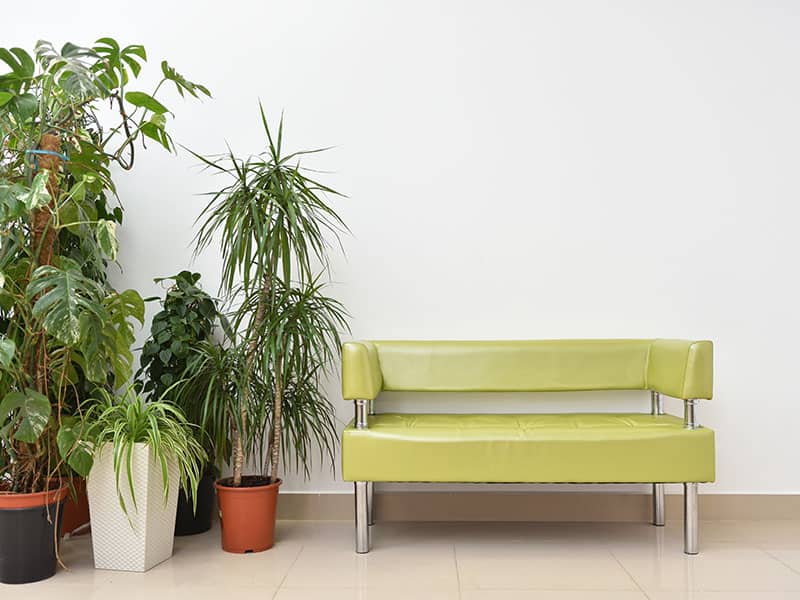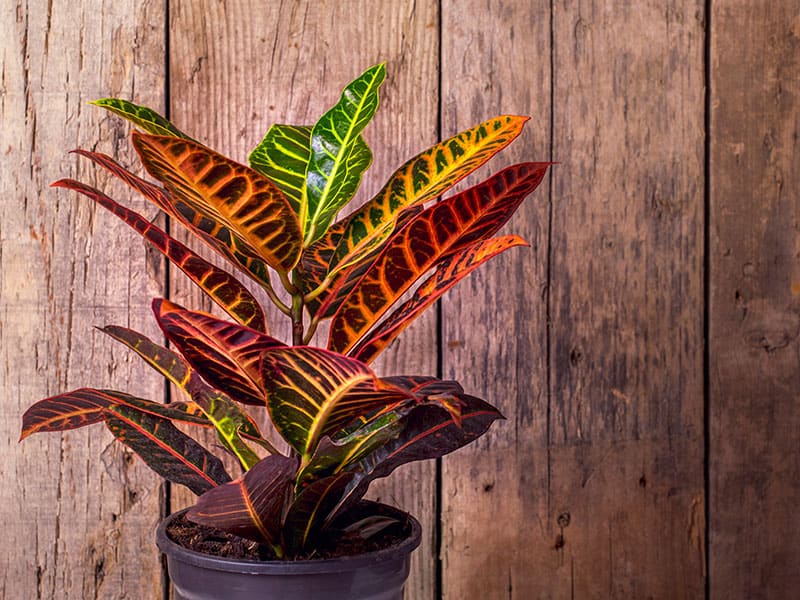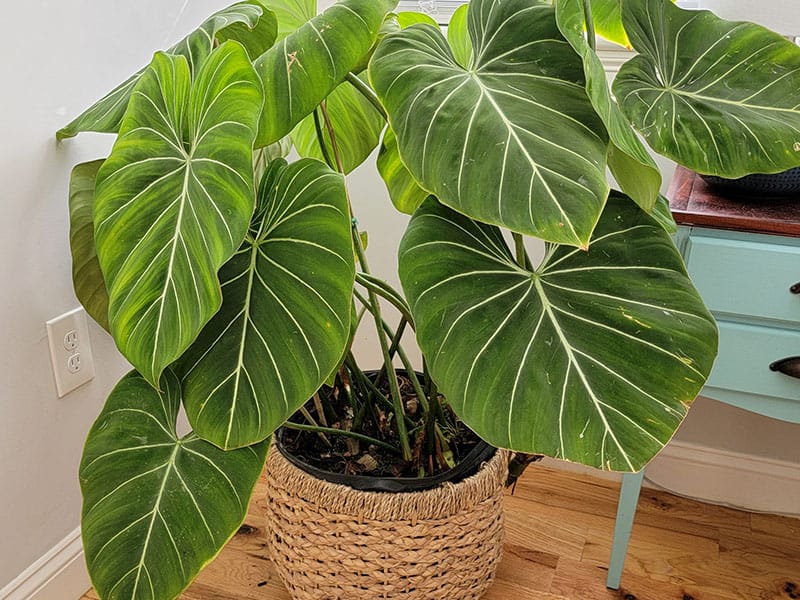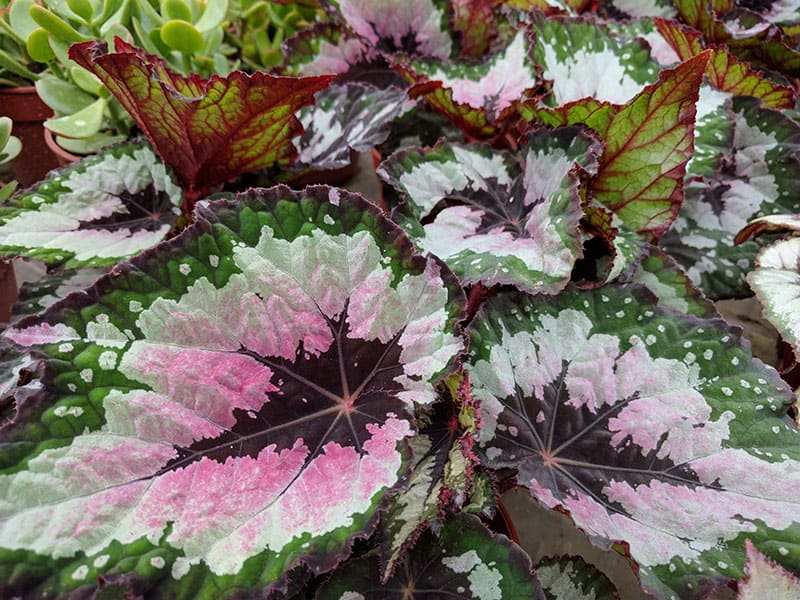15 Large Leaf Indoor Plants
Putting a large leaf indoor plant in an empty corner is an easy way to improve the look of your room. Also, you’ll spend less money on a plant than if you were to buy any artwork or decoration.
I also need to mention that some of these plants are great for use indoors because they filter the toxins in the air, creating a healthier environment.
To help you pick one or more large leaf plants, I created the list as a guide. Find more information and pictures of the plants below, as well as some useful growing advice!

1. Bird Of Paradise
Strelitzia is a botanical name of the beautiful tropical plant, commonly referred to as Bird of Paradise. It is a close relative to the Banana plant!
Unlike other tropical plants, Strelitzia is easy to grow. Also, it is a fast grower that you can grow indoors when the temperatures are chilly to induce maximum growth.
The flowers usually appear in the late winter. However, sometimes the Bird of Paradise blooms year-round. Keep in mind that Strelitzia is toxic to pets! My favorite variety is Giant Strelitzia nicolai!
Find out how simple to grow the unusual Bird of Paradise is!
Learn how to use indoor plants to decorate your home. You can see this video to know more:
2. Swiss Cheese Plant
Monstera Deliciosa, or Swiss Cheese plant, is known for its dark-green leaves with unusual holes. The holes or fenestrations are only for decorative purposes. Their purpose is to help the plant utilize sunlight more efficiently.
The Swiss Cheese plant is one of the most common indoor plants in many US homes. It is easy to grow, and the plant doesn’t require any special conditions. Watering is necessary every one or two weeks, which depends on the light exposure. Ideally, the soil needs to dry between waterings. You can also use filtered water to induce growth.
Swiss cheese plants like humidity. If you use a mist or humidifier around the plant will help it develop richer foliage.
Here are more Swiss Cheese growing tips!
3. Dragon Tree
A grown-up Dracaena marginata or Dragon tree is an indoor statement plant. With large and long, pointy foliage, tropical vibe, and low maintenance nature, the Dragon tree is adored by people around the world.
The keyword with Dragon tree is moderate. The plant thrives in moderate sunlight, moderate water, and moderate temperature. Sudden temperature fluctuations are deadly for the plant.
Also, keep track of the repotting schedule of your plant. You can repot it every two years once the plant has outgrown the current pot. Once it reaches the maximum height, repot every three years. But, use a pot of the same size to refresh the soil. Be careful not to damage the roots while repotting!
Discover more practical information on Dragon tree!
4. Croton Plant

In warm climates, Croton is an outdoor plant. But, in most areas, people grow Croton indoors. You can find different varieties of Croton plants, which have different growing requirements.
Some prefer more light than others, so find the location for your large leaf plant before you purchase the variety.
The most important requirement to have in mind is that the Croton plant loves humidity. Keeping a small humidifier around the plant will keep the plant healthy and the foliage vivid.
Find out how to identify what is wrong with your Croton!
5. Fiddle Leaf Fig
Ficus Lyrata is a botanical name of the plant you probably know as Fiddle Leaf Fig. The plant is native to Africa, where it can grow up to 40 or 50 feet. When grown as a household plant, the plant is usually around ten feet tall.
The plant needs 15 years to fully mature and reach the maximum height. But, after four years of planting Fiddle leaf fig, it becomes one of the most attractive large leaf ornamental plants. It features large, fiddle-shaped foliage.
Click here to learn how to choose the ideal indoor location for your Fiddle leaf fig.
Essential care tips for most beautiful Fiddle Leaf Fig. You can see this video to know more:
6. African Mask Plant
The African Mask Plant or Alocasia has stunning large leaves and thrives indoors. The plant loves warm, consistent temperatures, so keep the thermostat between 65 and 85 degrees Fahrenheit. Alocasia needs fertilizer during the growing season – spring and summer months. You can use any indoor plant fertilizer you have by hand.
Because Alocasia is toxic to humans and animals, be careful when choosing the location for it. The large and lush leaves may be attractive to toddlers or pets, so keep the plant out of reach.
Find out how to bring your Alocasia back to life if you notice drooping leaves!
7. Philodendron Xanadu
Under the name Thaumatophyllum Xanadu, you’ll find one of the most wonderful Philodendron species and indoor plants in general. It is a tall plant, with an upright growth habit and split leaves. Because of its unusual appearance, Philodendron Xanadu gives a tropical vibe to the room.
Basic growing conditions for Philodendron Xanadu are moderate light and well-draining soil. The plant loves light, but keep it out of direct sunlight, because it can burn the leaves. Also, ensure that the soil remains wet, but not soggy. You can also add a tiny amount of fertilizer every three weeks to help the plant grow faster.
Read the in-depth guide for growing Philodendron Xanadu.
8. Philodendron Gloriosum

Philodendron Gloriosum is a rare Philodendron. The plant is a crawler and has stunning foliage with pink edges and white or light pink veins. The leaves are large and lush, and the Glosorium variety is more expensive than other Philodendrons.
The key to growing the most beautiful Philodendron Gloriosum is to add horticultural charcoal to the potting mix when transplanting it. It will lighten the soil, provide aeration, remove toxins and make the soil sweeter. Additionally, by adding charcoal to the potting mix, you’ll create a soil structure similar to the native soil in which Gloriosum thrives.
Read more practical information on growing the Philodendron Gloriosum.
9. Banana Tree Plant
Don’t be surprised, the Banana Tree plant makes a statement and is an easy to grow houseplant. The botanical name of the plant is Musa oriana.
You’ll have to ensure enough light and water for your plant, and it will award you with a remarkable appearance.
The foliage is large and vivid green, with little white flowers. In most cases, Banana trees won’t produce fruits indoors.
Most varieties reach 30 feet when mature indoors. Also, you can find much smaller dwarf varieties suitable for compact spaces.
Discover which indoor Banana tree variety produces fruits!
Large Banana tree indoors? Yes! Here is how!
10. Rex Begonia

Rex Begonia is recognizable by its out-of-this-world foliage. You can find a wide range of hybrids with different colors, shapes, and textures.
I recommend the heart-shaped foliage or seashell swirls.
Rex Begonia features multicolored leaves and offers u fusion of colors. Most varieties have pink, burgundy, green combinations on the leaves, but there are hybrids with metallic silverish shades.
Rex Begonia is a breathtaking indoor plant, which comes from tropical areas. Therefore, it likes warm temperatures and sunlight.
Read the five best tips for taking care of Rex Begonia.
11. Prayer Plant
Calathea or Prayer plant has rich green foliage with green shades. The large foliage is the most adorable part of the plant! You’ve probably seen Calathea in offices, hotel lobbies, conference rooms, as the plant is low-maintenance, and grows in low-light conditions.
Calathea doesn’t like too much fertilizer or tap water. I recommend you use distilled water to ensure the best growth rate. Further, Calathea enjoys moderate watering – the roots need to be moist but not soggy.
Also, keep in mind that Calathea isn’t cold resistant. Considering it is a tropical plant, it is anticipated that the plant likes warmth. The ideal temperature for the Calathea plant is between 65 and 80 degrees.
Learn more about available Calathea varieties!
12. Fishtail Palm
Fishtail palm is an attractive palm tree, but it is a challenging plant to grow indoors. However, if you manage to keep your Fishtail palm or Caryota alive, it will reward you with a delightful look.
The palm needs high humidity, indirect lighting, moderate watering, and moisture. Warm and humid air is key to growing Fishtail palm indoors!
Indoors, the palm can reach around 8 feet or more in optimal growing conditions. Also, fishtail palm needs simple and sparse pruning to maintain the look. All you have to do is cut the tallest stalks under the fronds to keep the palm at its current height.
Read a comprehensive guide to growing the challenging, but beautiful Fishtail palm indoors!
13. European Olive
Olea Europa is a stunning indoor tree that is suitable for growing in containers indoors. To ensure maximum growth of your European olive indoors, you’ll have to plant the tree in the early spring or summer. The timing depends on your climate.
After planting, the European olive needs a lot of sunlight, at least six hours per day. Therefore, the ideal location for your freshly planted European olive is the southern window!
The tree also likes dry air and moderately warm temperatures.
Here is what you need to know before you grow European olive indoors.
14. Corn Plant
Corn plant or Dracaena fragrans is native to Africa and a popular indoor plant in Europe. Lately, the plant is becoming more popular in the USA!
It is a slow-growing plant with an upward growth habit. The plant resembles palm trees because of its thick stem with narrow, long, and large leaves. People sometimes refer to it as a False palm.
The corn plant is one of the easiest indoor large leaf plants to grow! It is adaptable and suitable for people who travel often.
However, keep it away from pets, because the Corn plant is toxic.
Read more information about the Corn plant.
Discover how to bring your Corn plant back to life. You can see this video to know more:
15. Rhapis Palm
Rhapis palm or BroadLeaf Lady Palm in containers indoors is considered a slow-growing plant. Outdoors, Lady Palm grows over ten inches per year.
Because of it, Lady Palm is perfect for compact spaces and it makes a statement decoration piece in every room. Also, Rhapis palm is known for its air-purifying features!
The ideal conditions for Rhapis palm are bright, indirect light! However, the plant is adjustable. If you put it somewhere in the shade, the Rhapis palm will survive, but it will grow slower. A location near the window is perfect for Rhapis palm.
Other growing conditions include pruning spent leaves and drenching the roots in the water!
Here is the complete guide on how to grow Rhapis palm indoors!
Large Leaves Plants Are Perfect For Lonely Corners Inside
Some people prefer vines and climbers, multiple succulent displays, or statement plants. If you want to improve the look of your room but not put too much effort into growing and choosing the plants, pick the plant with lush, rich, and large foliage.
The pop of green will brighten even the dullest corner in your home!
The best thing, most of the plants with large leaves are easy to grow with a few hacks!
What is your favorite large leaf plant? If you already have any of the plants from the list, please share your experience and growing tips! Don’t forget to like the article and come back for more interesting and inspirational gardening articles!

